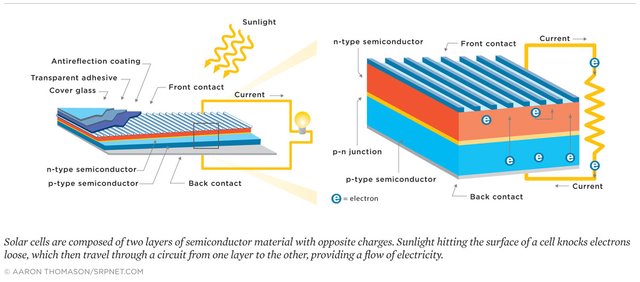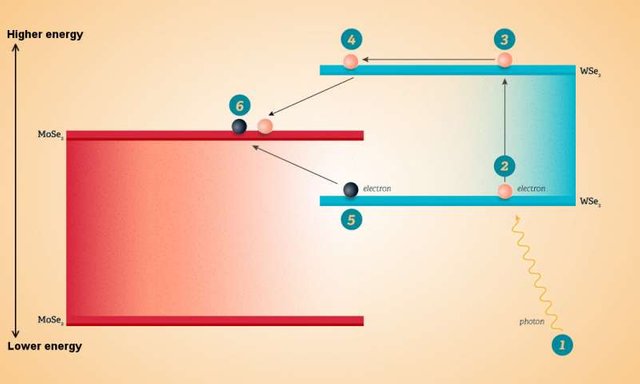50% increase of solar energy eficiency
Hi everyone :)
I recently read an article about Physicists at the University of California, Riverside developing a photodetector by combining two distinct inorganic materials that can, through quantum mechanics, lead to a higher efficiency of photovoltaic devices.
I want to share the informations of it, because I think it could be interesting for some of you too.
How a normal solar cell works
A solar cell is a device to convert sunlight into electricity.

If you take a closer look on the picture, you can see how a solar panel is made up. On top is an anti-reflective surface, to absorb the sunlight. Under it, there is a n-type semiconductor, doped with phosphorus, wich bonds with the silicon to create a positive charge and a p-type semiconductor, which is doped with boron, which bonds with the silicon to create a negative charge. Between them, there is the p-n junction, where electrons diffuse into the gaps in the p-type silicon. This results in a positive charge n-type and a negative charged p-type silicon, what creates an electric field across the solar cell. The photons of sunlight, have enough energy to seperate the 5th valenc electron of the silicon, making it able to move to the positive n-layer and the positive gap moves to the negativ p-layer. The seperartion of this charges creates a potential. If a person now connects the front contact and the back contact with a electric device, a electric circuit is created.
Photodectors in general
Photodetectors are sensors of light/other electromagnetic energy. They also have a p-n junction that converts light photons into current and are used for example in remote controls, solar cells, cameras or in cell phones, where they automatically regulate the brightness of LCD displays.
The more efficient version

The lab researchers stacked two atomic layers of tungsten diselenide (WSe2, an inorganic compound) on a single atomic layer of molybdenum diselenide (MoSe2, another inorganic compound of molybdenum and selenium), resulting in properties vastly different from those of the parent layers.
Difference to normal panels
In normal solar panels models, one photon can at most generate one electron. In the new type, one photon can generate two electrons or more through a process called electron multiplication. This multiplication results when photons strike the WSe2 layer. They knock loose an electron, freeing it to conduct through the WSe2. At the junction between WSe2 and MoSe2, the electron drops down into MoSe2. The kinetic energy given off is shooting the second electron from the WSe2 into the MoSe2, where both electrons become free to move and generate electricity -> normally an electron jumping from two states looses energy, here it creates another electron. The sresearchers say that heat can also help to get generate more electrons, expecting to get more than a doubling of electrons from higher temperatures.

from one electron, you get 2 or more in the end
It's nanotechnology
The materials have to be thinned down to dimensions nearing the electron’s wavelength, to create this multiplication. The advantage is that instead of producing waste heat, the solar cell can generate more power compared to the normal solar cells. Because of the materials are only one atom thick, the rearchers state, windows with integrated solar cells could be possible, because you can see through the material.
Imagine this glass facade could produce energy
Conclusion
There aren't many articles out yet so I don't have much information by now, but thinking about the possibilities, like suits, that carry litle solar cells in them to produce energy or windows that produce energy would be a great innvention. I think this kind of research is always a good step into the future of renewable energy.
I hope you enjoyed the post
Have a nice day :)
SourceTexthttps://ucrtoday.ucr.edu/49282https://www.ecnmag.com/news/2017/10/solar-energy-prototype-shows-how-tiny-photodetectors-can-double-their-efficiencyhttps://phys.org/news/2017-10-prototype-tiny-photodetectors-efficiency.htmlhttp://www.ucsusa.org/clean-energy/renewable-energy/how-solar-panels-work#.Wd4481u0MuWPictureshttps://ucrtoday.ucr.edu/wp-content/uploads/2017/10/electron-illlustration-356x254.jpghttp://www.ucsusa.org/sites/default/files/images/2015/12/energy-graphic-how-pv-solar-panel-works.jpghttps://i.ytimg.com/vi/ksWvwZeT2r8/maxresdefault.jpghttps://www.npcc.us/wp-content/uploads/2013/02/1030-Buildings-Looking-up-at-tall-glass-building-.jpg
Interesting post
Thank you :)
Complex af
I read that ECN article, I found it was informative. Tungsten and molybdenum outer shells are both in the 'd' orbital and they are both transition elements. I assume since the molecule they are using is WSe2 and MoSe2, there should be 4 valence electrons. The article didn't cover this. I am wondering why one photon wouldn't free 4 electrons instead of just 2. Thanks for the post.
Congratulations @aximot! You have completed some achievement on Steemit and have been rewarded with new badge(s) :
Click on any badge to view your own Board of Honor on SteemitBoard.
For more information about SteemitBoard, click here
If you no longer want to receive notifications, reply to this comment with the word
STOP